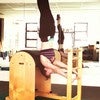Description
Want to know more about pelvic floor dysfunction? Check out Claire Sparrow's bestselling book, HOPE For Your Pelvic Floor.
About This Video
Transcript
Read Full Transcript
Hi there, everyone. I'm Claire Sparrow. I'm a 2nd generation Pilates teacher, Polestar Educator, and best selling author. Today, I'm going to shed some light on what pelvic organ prolapse actually is. We're gonna start by busting some of the myths.
Then I'm going to describe to you what pelvic organ prolapse actually is and some of the symptoms that women may be experiencing if they have prolapse. And then I'm gonna give you some considerations. Things for you to go away and start to think about and apply into your teaching. First of all, we're gonna start with some of the myths so that we're all on the same page. It's often a assumed that only women who've had a vaginal delivery of a baby will be at risk of having prolapse.
This is not true. Any woman can be at risk of having a prolapse, whether they've had a baby or not, whether they've had the baby vaginally or by cesarean section. So we can bust that myth straight away. One of the other myths is that it will be automatically related to consonants. To whether or not someone is incontinent in their bowels or not. So it's not always the incontinence as the automatic piece of prolapse.
1 of the other myths that we have is that it's because your pelvic floor muscles are weak, and we're definitely going to talk a little bit more about that. Because that's the common assumption and it's not accurate at all. Your pelvic floor muscles need to work in a balanced and responsive way, and being strong, having strength is only one part of that. So it's really important that we bust those myths straight out of the gate. The second part that we're going to cover is the deafness So when you look at a definition of pelvic organ prolapse, you're going to read something like the Oregon and Oregon has fallen out due to weak muscles.
So the word prolapse actually means to fall out. So we are actually using an incorrect word to describe what prolapse is because that entire definition that we have inherited over time isn't exactly how our body works because our prolapse is in fact the displacement of an organ. So that just means it's when 1 or more of your organs has moved location. And it's moved location because of an imbalance in the structure rather than our weakness in the structure. Weakness might be one little component of it.
It's not the whole part. It's just one. It's an imbalance in all of that tissue. And I brought a model with me to show you today to help explain that a little bit further. So this is called a 10 segravity model. Some of you will be familiar with 10 segravity models. This particular one is a model of the pelvis.
So if I show it up here with our skeleton here, you can see the relationship that this model has with your pelvis. When we look at this model, we can see that none of the struts, none of the the wooden struts are actually in contact. They're not touching one another. They're all actually suspended in the elastic structure. And that is how our organs are in our body.
They are also suspended in the elastic structure of our body, which is very different to the idea that we've inherited that things are stacked up like building blocks and the idea that things can fall out If something is suspended, I e, it is being held from all different directions, it doesn't make sense then to think of it as something fallen out. It is just that the suspension system has got a king in it somewhere. Often for women who have given birth vaginally, 90% minimum, 90% of those women have had some kind of birth injury. And a birth injury whether it's a tear or an episiotomy when the doctor has had to cut in order to let your baby out. So perhaps a cut to the perineum, that will then build up scar tissue over time.
Scar tissue is dense tissue rather than this lovely elastic suspension it's got, stuck stiffness restriction within it. That is a common cause of pelvic corg and prolapse. That scar tissue build up that imbalance in the suspension system. So instead of the organ being suspended, it's actually being pulled out of alignment. And that pooling out of alignment might actually be what is moving your organ into your vaginal wall.
So pelvic organ prolapse could be 1 of 3 organs that have displaced The most common is cystocele. The second most common is rectocele. And the third is the uterine prolapse. Cisticeal is when the bladder has displaced into the vaginal wall. Then your recto seal, as the name suggests, it's when your rect has displaced into the vaginal wall. And then finally, your uterine, that's when your uterus has displaced.
And it's really important that we keep using the word displaced because it reminds us that if something's displaced, it can be replaced again in really, really positive way of viewing it. And my book hope for your pelvic floor. I talk a lot about the importance of the language and the labeling that we use around our body, around the conditions that we experience, And one of the big things that I teach is about pelvic organ prolapse because it hasn't dropped its place. So just keep that in mind when you're considering this. It's also important as I said that we talk about some of the symptoms that women might be experiencing, and that actually at least 50% of women experience pelvic organ prolapse. I know that's that's a pause moment for you to really acknowledge that.
That 50% of women report symptoms. Now, unfortunately, I know from the many, many women that I've worked with that actually many women don't know what the symptoms are. So if you don't know what the symptoms are, you're not going to be reporting. Often, we didn't know really a lot about our pelvic floor before we perhaps had a problem with it. And this is the time you're then learning about it without much of a frame of reference. So the more we can educate ourselves on the palvic floor, the experience, the almost the what to expect from your pelvic floor, the better placed we are to heal it and take control of it when things do go a little bit awry.
So some of those symptoms women might experience a feeling of bulging or dragging down into the vagina, it can often feel like there's a tampon stuck half in half out, and it can feel uncomfortable. Women can find it difficult to sit even as I am or to cross legs because there's extra tissue there. That can feel really uncomfortable. It can rub. If you think about it, that's not a nice sensation to feel your you rub against other tissue, especially when you can feel that it is in an unusual or different position. Other symptoms that women might have are pain. So they might have pain into the groin.
They might have pain into the hip. They might have sciatic pain. I know there's light bulbs going off now because these are things that come up commonly within our classes. We wouldn't necessarily recognize or know them to be symptoms of prolapse. Other things that they may experience, of course, incontinence.
So they might have urinary incontinence. That's someone I think we know or are aware of more commonly. There's lots of adverts and things on television to to wear pads and things like that, which actually are not helping solve the problem, and you're in a great position as Plati's teachers to help actually solve the problem for women. So let work on that. The other thing that isn't as commonly spoken about is bowel incontinence and problems around bowel movements in general.
You might be surprised to know that many women with rec to CO will have difficulty fully emptying their bowels and some women in extreme cases have to manually help themselves to fully empty their bowels. I know. This is what women are going through on a daily basis. And it's shocking. It's something that we can work on, and we can help them to improve. Some of the other symptoms will be pain during intimacy or not able to have a proper fulfilling sex life.
Women might not be able to feel pleasure the way that they did before. And this is all down to the pelvic organ prolapse. And these are everyday standard of living situations that women are going through and that we can really help them with. So that's where we need to go next. How how are you going to help women in your classes?
We're really scratching the surface of what prolapse is and and and how you can help, I'd love to give you thoughts a thought process, a way that you can go on and consider how to support people with the tools and the skills that you have. One of the things I think that you need to do to start with, and I feel really strongly about it, is screening women. We all do it when clients come and join us for class, our studios and our classes and and the community, we screen them. We have a form. They fill things out. You're getting all that information.
Please just include even one little question that feels, accessible to you and will help your clients to start to open up that conversation about their pelvic floor. Maybe it's do you have palvic organ prolapse. Do you have any symptoms with your pelvic floor anything that will help you to open up that initial conversation with new clients. The second thing that I love you to do, just talk about it. It's fine. Just talk about it because the more we talk about it, talk about it with your teammates.
Talk about it with your clients. Just talk. Then it becomes so much easier for people to come to you when I first started opening up about my own experiences of pelvic organ prolapse, more and more people started going, me too. Hands up. Yes. I have symptoms too. And then it made it so much easier for me to help more people because I was open.
I was able to have those conversations. So if you can do that within all of the different environments that you find yourself and it truly will help to empower all of us women to own it, to take charge, take control of our pelvic health, and then it will help you to help the women in your classes. And then within classes, I'd love it if you could actually address the pelvic floor in your classes in a holistic way. It's not like in our classes, we are ever solely exercising the pelvic floor. It's a postural muscle. It's part of our whole system.
It's responsive. So we're not saying, I'm not suggesting we isolate your pelvic floor in any way. What I'm suggesting is that you offer opportunities for women to know tests, do they feel something with their pelvic floor here? Equally, do they notice any of their pelvic floor symptoms. So if you've already screened them, you'll know if they have prolapse, hopefully. And you can see If when we're doing this movement, you feel any of your symptoms, then we can modify.
We can alter that exercise. Equally if this screening hasn't happened or you're in a group environment, you can just say if you feel any bulging into your pelvic floor if you feel any downward pressure. If you feel any pain, We're gonna alter that exercise so that you don't feel that, and you alter it as your skill set allows. Then what I'd really like you to be able to do is offer some more movement to bring balance. So we talked about we looked at this 10 segravy model of the pelvis. So if we want to help women to bring the organ back, in alignment so to restore it.
That we need to do movements that's gonna help that. So we need to bring balance through all of the joint of the pelvis. So getting the hips moving without the lumber joining in. The pelvic floor muscles need to lengthen, you know, that the pelvic floor muscles were actually designed to unfurl at the very least to three times their resting length. That's huge, isn't it? Three times their resting length.
So if you think about situations like footwork, fantastic place to help women to feel the length and balance out, especially women who have had a birth injury and they might have some restriction through often the left side of their pelvic floor, you can guide and support them to work on that. We'll be doing some of those things in reformer classes here so you can actually experience that in your own body as well. So finding that balance is gonna be really, really important. And then I'd also like you to look four times where the influencers, I like to just use that silly analogy because I think it helps us to not take it so seriously and to really make an impact. There are a lot of areas around the body, around the pelvic, floor that are influencers and not always in a good way for your pelvic floor.
Glutes, for example, can often be over recruiting and not allowing for your pelvic floor muscles to be responsive and engage as for those muscles, those influencers to release. So looking out for when they're overworking. And then finally, not at the beginning, but finally, teaching ways that women can create a responsive pelvic floor. So rather than trying to work those muscles in isolation, can you do things that are going to invite the pelvic floor to interact to activate in the way that they would do in real life. That will be your final piece, the strength piece, the we call it neuromuscular coordination when your brain and body are communicating well together.
And that happens when we've released the tension, when we have, you know, the tension of those influencers and when we've brought balance back to the movement of all of the structures around your pelvis. I know that's a lot. That's a lot to take in in a short space of time. And, honestly, we are just scratching the surface. This is a hugely important topic for me And I've worked with so many women where we've made massive impact where they've been waiting for surgery. And in the time they were waiting, We've done the work, and their surgeon has said, nope. We can't do better than that.
Keep doing what you're doing. So this work if you can shift your mindset from the the myths, the traditional ways we've thought about pelvic organ prolapse, and you approach it with the tools and skills that you actually already have on this bit of knowledge, you can make a really fantastic impact on women's lives. And this is something that I teach constantly. I've written extensively about in my book hope for your pelvic floor. So if you want to know more, please read that. I love it if you reach out in the in the forum here on Pilates any time because I can engage with you there and answer any questions that you might have elaborate on anything that has come up for you particularly in this tutorial today.
And I just really hope that it makes you think a little differently and work a little differently from here on in and thank you for sharing your time with me today. Bye, everyone.
Comments
You need to be a subscriber to post a comment.
Please Log In or Create an Account to start your free trial.



















